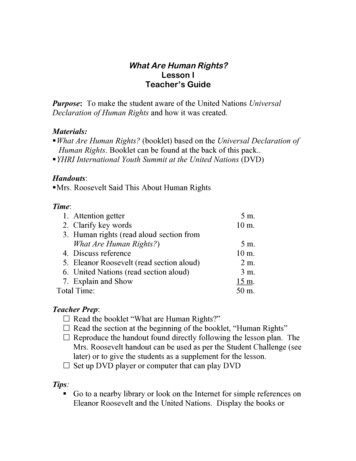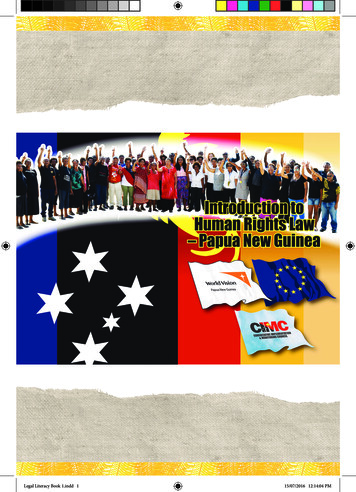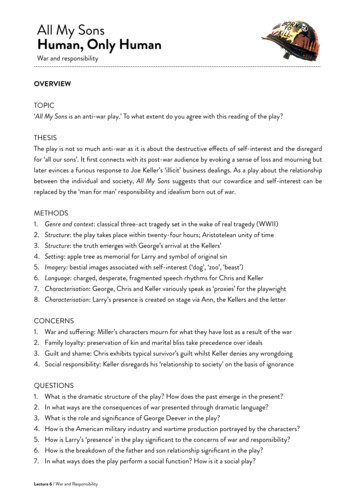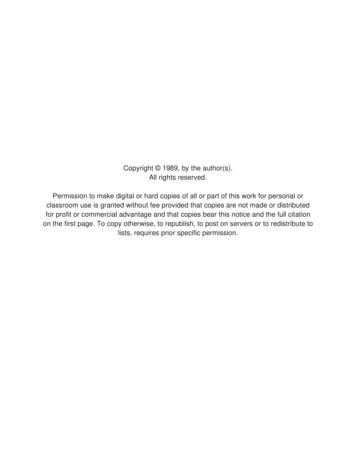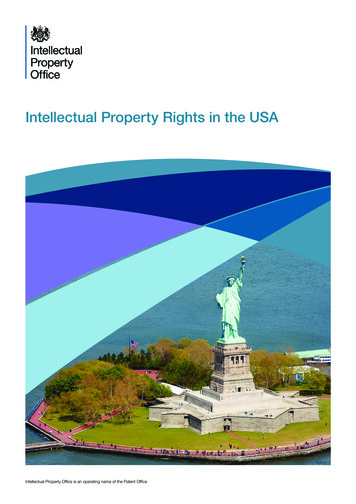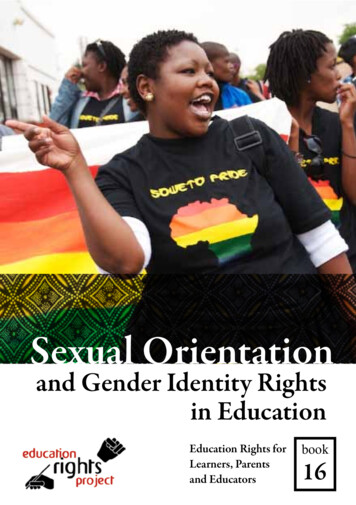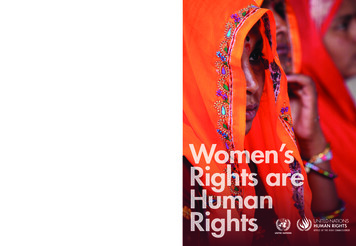
Transcription
Women’s Rights are Human RightsDesigned and Printed at United Nations, Geneva1404379 (E) – November 2014 – 3,350 – HR/PUB/14/2United Nations publicationSales No. E.14.XIV.5ISBN 978-92-1-154206-2Women’sRights areHumanRights
iWomen’sRights areHumanRightsNew York and Geneva, 2014
WOMEN’S RIGHTS ARE HUMAN RIGHTSNOTEThe designations employed and the presentation of the material in this publication do not imply theexpression of any opinion whatsoever on the part of the Secretariat of the United Nations concerning thelegal status of any country, territory, city or area, or of its authorities, or concerning the delimitation of itsfrontiers or boundaries.Symbols of United Nations documents are composed of capital letters combined with figures. Mention ofsuch a figure indicates a reference to a United Nations document.HR/PUB/14/2UNITED NATIONS PUBLICATIONSALES NO. E.14.XIV.5ISBN 978-92-1-154206-6E-ISBN 978-92-1-056789-3 2014 UNITED NATIONSALL WORLDWIDE RIGHTS RESERVED
iiiCONTENTSINTRODUCTION.1I. PROTECTION OF THE HUMAN RIGHTS OF WOMEN UNDERINTERNATIONAL LAW.3A. International human rights instruments.4B. Regional instruments.7II. GLOBAL COMMITMENTS.11A. Vienna Declaration and Programme of Action.12B. International Conference on Population and Development.12C. Beijing Declaration and Platform for Action.13D. Millennium Development Goals.14E. United Nations Conference on Sustainable Development.15III. UNITED NATIONS BODIES.19A. The Human Rights Council and its mechanisms.19B. The Security Council.21C. The Commission on the Status of Women.21IV. KEY CONCEPTS.25A. The public-private divide.26B. Universality of human rights.27C. Non-discrimination and equality between women and men.29D. Equality and equity.33E. Gender.35F. Intersectionality and multiple forms of discrimination.37
ivWOMEN’S RIGHTS ARE HUMAN RIGHTSV. THE HUMAN RIGHTS FRAMEWORK IN PRACTICE.41A. Women’s rights in public and political life.43B. Sexual and reproductive health and rights.50C. Women’s right to an adequate standard of living.62D. Violence against women.73E. Impact of migration and displacement on the enjoyment ofwomen’s rights.86F. Women’s human rights in conflicts and crises .92G. Women’s access to justice. 109
1INTRODUCTIONAttaining equality between women and men and eliminating all formsof discrimination against women are fundamental human rights andUnited Nations values. Women around the world nevertheless regularlysuffer violations of their human rights throughout their lives, and realizingwomen’s human rights has not always been a priority. Achieving equalitybetween women and men requires a comprehensive understanding of theways in which women experience discrimination and are denied equalityso as to develop appropriate strategies to eliminate such discrimination.The United Nations has a long history of addressing women’s humanrights and much progress has been made in securing women’s rightsacross the world in recent decades. However, important gaps remain andwomen’s realities are constantly changing, with new manifestations ofdiscrimination against them regularly emerging. Some groups of womenface additional forms of discrimination based on their age, ethnicity,nationality, religion, health status, marital status, education, disability andsocioeconomic status, among other grounds. These intersecting forms ofdiscrimination must be taken into account when developing measures andresponses to combat discrimination against women.This publication provides an introduction to women’s human rights,beginning with the main provisions in international human rights law andgoing on to explain particularly relevant concepts for fully understandingwomen’s human rights. Finally, selected areas of women’s human rights areexamined together with information on the main work of United Nationshuman rights mechanisms and others pertaining to these topics. The aimof the publication is to offer a basic understanding of the human rights ofwomen as a whole, but because of the wide variety of issues relevant towomen’s human rights, it should not be considered exhaustive.
I.Protection ofthe human rightsof women underinternational lawSince the founding of the United Nations, equality between men andwomen has been among the most fundamental guarantees of humanrights. Adopted in 1945, the Charter of the United Nations sets out asone of its goals “to reaffirm faith in fundamental human rights, in thedignity and worth of the human person, [and] in the equal rights of menand women”. Furthermore, Article 1 of the Charter stipulates that one ofthe purposes of the United Nations is to promote respect for human rightsand fundamental freedoms “without distinction as to race, sex, languageor religion”. This prohibition of discrimination based on sex is repeated inits Articles 13 (mandate of the General Assembly) and 55 (promotion ofuniversal human rights).In 1948, the Universal Declaration of Human Rights was adopted. It,too, proclaimed the equal entitlements of women and men to the rightscontained in it, “without distinction of any kind, such as . sex, .” Indrafting the Declaration, there was considerable discussion about the use3
4WOMEN’S RIGHTS ARE HUMAN RIGHTSof the term “all men” rather than a gender-neutral term.1 The Declarationwas eventually adopted using the terms “all human beings” and “everyone”in order to leave no doubt that the Universal Declaration was intended foreveryone, men and women alike.A. INTERNATIONAL HUMAN RIGHTS INSTRUMENTSAfter the adoption of the Universal Declaration, the Commission on HumanRights began drafting two human rights treaties, the International Covenanton Civil and Political Rights and the International Covenant on Economic,Social and Cultural Rights. Together with the Universal Declaration, thesemake up the International Bill of Human Rights. The provisions of the twoCovenants, as well as other human rights treaties, are legally binding onthe States that ratify or accede to them. States that ratify these treatiesperiodically report to bodies of experts, which issue recommendationson the steps required to meet the obligations laid out in the treaties.These treaty-monitoring bodies also provide authoritative interpretationsof the treaties and, if States have agreed, they also consider individualcomplaints of alleged violations.2Both Covenants use the same wording to prohibit discrimination basedon, inter alia, sex (art. 2), as well as to ensure the equal right of menand women to the enjoyment of all rights contained in them (art. 3). TheInternational Covenant on Civil and Political Rights guarantees, amongother rights, the right to life, freedom from torture, freedom from slavery,the right to liberty and security of the person, rights relating to due processin criminal and legal proceedings, equality before the law, freedom ofmovement, freedom of thought, conscience and religion, freedom ofassociation, rights relating to family life and children, rights relating tocitizenship and political participation, and minority groups’ rights to theirculture, religion and language. The International Covenant on Economic,Johannes Morsink, “Women’s rights in the Universal Declaration”, Human RightsQuarterly, vol. 13, No. 2 (May 1991).2For more information on the human rights treaty system, see OHCHR, Fact Sheet No. 30:The United Nations Human Rights Treaty System and OHCHR, Fact Sheet No. 7:Individual Complaint Procedures under the United Nations Human Rights Treaties.1
I. PROTECTION OF THE HUMAN RIGHTS OF WOMEN UNDER INTERNATIONAL LAWSocial and Cultural Rights guarantees, for instance, the right to work, theright to form trade unions, rights relating to marriage, maternity and childprotection, the right to an adequate standard of living, the right to health,the right to education, and rights relating to culture and science.In 1967, United Nations Member States adopted the Declaration onthe Elimination of Discrimination against Women, which states thatdiscrimination against women is an offence against human dignity andcalls on States to “abolish existing laws, customs, regulations and practiceswhich are discriminatory against women, and to establish adequate legalprotection for equal rights of men and women”. Less than a year latera proposal for a legally binding treaty on women’s rights was made.The Convention on the Elimination of All Forms of Discrimination againstWomen was adopted by the General Assembly in 1979. Its preambleexplains that, despite the existence of other instruments, women still do notenjoy equal rights with men.The Convention articulates the nature and meaning of sex-baseddiscrimination, and lays out State obligations to eliminate discriminationand achieve substantive equality. As with all human rights treaties, onlyStates incur obligations through ratification. However, the Conventionarticulates State obligations to address not only discriminatory laws, butalso practices and customs, and discrimination against women by privateactors.With these general principles as an overarching framework, the specificobligations of States to eliminate discrimination against women in political,social, economic and cultural fields are laid out in 16 substantive articles.The Convention covers both civil and political rights (rights to vote, toparticipate in public life, to acquire, change or retain one’s nationality,equality before the law and freedom of movement) and economic, socialand cultural rights (rights to education, work, health and financial credit).The Convention also pays specific attention to particular phenomena suchas trafficking, to certain groups of women, for instance rural women, andto specific matters where there are special risks to women’s full enjoymentof their human rights, for example marriage and the family.5
6WOMEN’S RIGHTS ARE HUMAN RIGHTSThe Convention defines discrimination in its article 1 as “ any distinction,exclusion or restriction made on the basis of sex which has the effect orpurpose of impairing or nullifying the recognition, enjoyment or exerciseby women, irrespective of their marital status, on a basis of equality of menand women, of human rights and fundamental freedoms in the political,economic, social, cultural, civil or any other field.”Such discrimination encompasses any difference in treatment on thegrounds of sex which: Intentionally or unintentionally disadvantages women; Prevents society as a whole from recognizing women’s rights inboth the private and the public spheres; Prevents women from exercising the human rights and fundamentalfreedoms to which they are entitled.The Convention also specifies the different ways in which State partiesare to eliminate discrimination, such as through appropriate legislationprohibiting discrimination, ensuring the legal protection of women’srights, refraining from discriminatory actions, protecting women againstdiscrimination by any person, organization or enterprise, and modifyingor abolishing discriminatory legislation, regulations and penal provisions.The Convention foresees that achieving equality may require positiveaction on the part of the State to improve the status of women. To acceleratewomen’s actual equality in all spheres of life, States are permitted to usetemporary special measures for as long as inequalities continue to exist.The Convention thus reaches beyond the narrow concept of formal equalityand aims for equality of opportunity and equality of outcome. Temporaryspecial measures are both lawful and necessary to achieve these goals. Inprinciple, these measures should be removed once equal status has beenachieved.Importantly, the Convention adds new, substantive provisions to the otherinstruments which also deal with equality and non-discrimination. Article5 establishes that in addition to recognizing women’s legal equality andpromoting their de facto equality, States should also strive to eliminate the
I. PROTECTION OF THE HUMAN RIGHTS OF WOMEN UNDER INTERNATIONAL LAWsocial, cultural and traditional patterns that perpetuate harmful genderstereotypes and to create an overall framework in society that promotesthe realization of women’s full rights.The Convention on the Rights of the Child (art. 2) and the Convention onthe Protection of the Rights of All Migrant Workers and Members of TheirFamilies (art. 7) also prohibit discrimination based on sex. The Conventionon the Rights of Persons with Disabilities (art. 6) recognizes the multiplediscrimination that women with disabilities are subjected to, and requiresState parties to address this by taking “all appropriate measures to ensurethe full development, advancement and empowerment of women” inthe enjoyment of their human rights. In its general recommendation No.25 (2000) on gender-related dimensions of racial discrimination, theCommittee on the Elimination of Racial Discrimination, which overseescompliance with the International Convention on the Elimination of AllForms of Racial Discrimination, also recognized the gender dimensionsof racial discrimination and said it would “endeavour in its work to takeinto account gender factors or issues which may be interlinked withracial discrimination.” The Committee against Torture, which monitorsthe Convention against Torture and Other Cruel, Inhuman or DegradingTreatment or Punishment, also regularly addresses issues of violenceagainst women and girls.B. REGIONAL INSTRUMENTSIn addition to international human rights standards, regional human rightstreaties, too, include crucial provisions aimed at promoting and protectingwomen’s human rights.3Regional human rights treaties also have oversight mechanisms to assess compliancewith their provisions by the States that have ratified them. These include the AfricanCommission on Human and Peoples’ Rights, the Inter-American Commission on HumanRights and the Inter-American Court of Human Rights, the Council of Europe and theEuropean Court of Human Rights. Some of their work is highlighted in this publication.37
8WOMEN’S RIGHTS ARE HUMAN RIGHTSThe African (Banjul) Charter on Human and Peoples’ Rights was adoptedin 1981 by the Organization of African Unity. Its article 2 prohibitsdiscrimination on any grounds, including sex, in the enjoyment of the rightsguaranteed by the Charter. Article 18 specifically mentions the obligationof African States to “ensure the elimination of every discrimination againstwomen and also ensure the protection of the rights of the woman andthe child as stipulated in international declarations and conventions”. TheCharter’s Protocol on the Rights of Women in Africa (Maputo Protocol)was adopted in 2003.The Charter of the Organization of American States includes a nondiscrimination provision in its chapter II, article 3 (l), and the AmericanConvention on Human Rights in its article 1. Moreover, in 1994 theOrganization adopted the Inter-American Convention on the Prevention,Punishment and Eradication of Violence against Women (Belém do ParáConvention).The European Convention on Human Rights and Fundamental Freedomsprohibits discrimination on any grounds, including sex, in the enjoymentof rights contained in the Convention (art. 14). Since 1998 individualscan bring complaints to the European Court of Human Rights based onallegations of violations of the Convention. In 2011 the Council of Europeadopted a new Convention on preventing and combating violence againstwomen and domestic violence (Istanbul Convention).Regional political organizations, including the Association of SoutheastAsian Nations, the South Asian Association for Regional Cooperation,the Economic Community of West African States and the Southern AfricanDevelopment Community, have also adopted protocols and resolutionsand issued declarations pertaining to women’s human rights.
II.GlobalcommitmentsWomen’s rights have been at the heart of a series of internationalconferences that have produced significant political commitments towomen’s human rights and equality. Starting in 1975, which was alsoInternational Women’s Year, Mexico City hosted the World Conferenceon the International Women’s Year, which resulted in the World Plan ofAction and the designation of 1975–1985 as the United Nations Decadefor Women. In 1980, another international conference on women washeld in Copenhagen and the Convention on the Elimination of All Forms ofDiscrimination against Women was opened for signature. The third WorldConference on Women was held in Nairobi, with the Committee on theElimination of Discrimination against Women having begun its work in1982. These three world conferences witnessed extraordinary activismon the part of women from around the world and laid the groundwork forthe world conferences in the 1990s to address women’s rights, includingthe Fourth World Conference on Women held in Beijing in 1995 (seebelow). In addition, the rights of women belonging to particular groups,such as older women, ethnic minority women or women with disabilities,11
12WOMEN’S RIGHTS ARE HUMAN RIGHTShave been also addressed in various other international policy documentssuch as the International Plans of Action on Ageing (Vienna, 1982 andMadrid, 2002), the Durban Declaration and Programme of Action (2001)and the World Programme of Action concerning Disabled Persons (1982).A. VIENNA DECLARATION AND PROGRAMME OF ACTION4In 1993, the World Conference on Human Rights was held in Vienna. Itsought to review the status of the human rights machinery in place at thetime. Women’s rights activists mobilized to ensure that women’s humanrights were fully on the agenda of the international community under therallying cry “Women’s Rights are Human Rights.” Particularly around theissue of violence against women, civil society activists organized tribunalsto put the spotlight on violations of women’s rights, previously unaddressedbecause they were considered part of the private sphere, taboo or simplyaccepted as an inevitable part of women’s lives. The Conference wassuccessful in adopting the Vienna Declaration and Programme of Action,which stated that “the human rights of women and of the girl-child are aninalienable, integral and indivisible part of universal human rights” (para.18) and placed particularly heavy emphasis on eliminating all forms ofgender-based violence. Importantly, the Programme of Action also calledfor “the eradication of any conflicts which may arise between the rightsof women and the harmful effects of certain traditional or customarypractices, cultural prejudices and religious extremism” (para. 38).B. INTERNATIONAL CONFERENCE ON POPULATION ANDDEVELOPMENTThe International Conference on Population and Development, whichwas held in 1994, represented a milestone for women’s rights. While theConference was focused on population issues, the delegates meeting inCairo agreed that population was not only about demographics but, moreA/CONF.157/24 (Part I), chap. III.4
II. GLOBAL COMMITMENTSimportantly, about people. The issues taken up in its Programme of Action5are fundamentally related to women’s human rights, including genderequality, the family, reproductive health, birth control and family planning,women’s health, as well as immigration and education of women.Importantly, the Programme of Action is explicitly grounded in humanrights and proclaims that “advancing gender equality and equity andthe empowerment of women, and the elimination of all kinds of violenceagainst women, and ensuring women’s ability to control their own fertility,are cornerstones of population and development-related programmes.”The Conference was also important for its clear statement of reproductiverights, explaining that these “rest on the recognition of the basic right ofall couples and individuals to decide freely and responsibly the number,spacing and timing of their children and to have the information andmeans to do so, and the right to attain the highest standard of sexualand reproductive health. It also includes their right to make decisionsconcerning reproduction free of discrimination, coercion and violence, asexpressed in human rights documents.”The Programme of Action sets specific targets for: the provision ofuniversal education; the reduction of infant, child and maternal mortality;and ensuring universal access to reproductive health care, includingfamily planning, assisted childbirth and prevention of sexually transmittedinfections, including HIV/AIDS, by 2015. Follow-up conferences havebeen organized to assess progress towards these goals, and inequality andlack of accountability constitute ongoing challenges to their achievement.C. BEIJING DECLARATION AND PLATFORM FOR ACTION6Adopted during the Fourth World Conference on Women in September1995, the Beijing Declaration and Platform for Action focused on 12areas concerning the implementation of women’s human rights and56Report of the International Conference on Population and Development, Cairo, 5–13 September1994 (United Nations publication, Sales No. E.95.XIII.18), chap. I, resolution 1, annex.Report of the Fourth World Conference on Women, Beijing, 4–15 September 1995 (UnitedNations publication, Sales No. E.96.IV.13), chap. I, resolution 1, annexes I and II.13
14WOMEN’S RIGHTS ARE HUMAN RIGHTSset out an agenda for women’s empowerment. It builds on the resultsof the previous three world conferences on women, but is considered asignificant achievement in explicitly articulating women’s rights as humanrights. The Platform for Action includes a series of strategic objectives toeliminate discrimination against women and achieve equality betweenwomen and men. It involves political and legal strategies on a global scalebased on a human rights framework. The Platform for Action is the mostcomprehensive expression of States’ commitments to the human rights ofwomen.Subsequent reviews of the implementation of the Beijing Declaration andPlatform for Action have revealed that although significant progress hasbeen made in some areas of women’s human rights, “discriminatorylegislation as well as harmful traditional and customary practices andnegative stereotyping of women and men still persist” particularly in family,civil, penal, labour and commercial laws or codes, or administrative rulesand regulations.7 Both the 2005 and the 2010 reviews of the Platformconcluded that de jure and de facto equality had not been achieved inany country in the world and the 2010 review recognized that even wherelegal reforms had taken place, they were often ineffectively enforced.8D. MILLENNIUM DEVELOPMENT GOALSIn 2000, the international community agreed to eight time-bounddevelopment goals to be achieved by 2015, including a goal ongender equality and the empowerment of women, as well as one on thereduction of maternal mortality. Seven of the Goals have specific targets tomeasure progress. Although they have shortcomings from a human rightsperspective, the Millennium Development Goals are an important politicalcommitment which has galvanized international support for some of theworld’s most daunting problems.General Assembly resolution S-23/3, annex, para. 27.E/2010/4–E/CN.6/2010/02, paras. 307–310.78
II. GLOBAL COMMITMENTSWith respect to women’s rights, Millennium Development Goal 3is to promote gender equality and empower women. However, itscorresponding target relates only to eliminating gender disparities ineducation by 2015. While girls’ access to education is imperative forachieving gender equality, this narrow target is insufficient for measuringprogress on achieving gender equality and empowering women. Goal 3also includes indicators on the share of women in wage employment in thenon-agricultural sector and in national parliaments, but these do not havebenchmarks or deadlines. Critical issues such as violence against womenand discriminatory laws are not addressed.Millennium Development Goal 5 aims to reduce the maternal mortality ratioby three quarters, between 1990 and 2015. Unfortunately, at the 2010High-level Plenary Meeting of the General Assembly on the MillenniumDevelopment Goals, it was revealed to be the most off track of all of theGoals, despite the fact that the knowledge and the tools are available tomake pregnancy and childbirth a safe experience for women. In 2010,the Secretary-General launched the Global Strategy for Women’s andChildren’s Health, setting out key actions to improve the health of womenand children worldwide.Integrating human rights and gender equality throughout the MillenniumDevelopment Goals and in the post-2015 development agenda are key toachieving meaningful progress.E. UNITED NATIONS CONFERENCE ON SUSTAINABLE DEVELOPMENTThe United Nations Conference on Sustainable Development (“Rio 20”)brought Heads of State and Government to Brazil in 2012, to appraiseprogress in the implementation of agreements struck since the landmark1992 United Nations Conference on the Environment and Development inRio de Janeiro. At “Rio 20”, countries renewed their political commitmentto sustainable development, agreed to establish a set of sustainabledevelopment goals and established a high-level political forum onsustainable development. Importantly, the outcome document, entitled “The15
16WOMEN’S RIGHTS ARE HUMAN RIGHTSfuture we want”,9 also reaffirms the commitments of States to “women’sequal rights, access and opportunities for participation and leadershipin the economy, society and political decision-making” and includesexplicit references to accelerating the implementation of commitments inthe Convention on the Elimination of All Forms of Discrimination againstWomen, the Beijing Platform for Action and the Millennium Declaration.The outcome document also states that “gender equality and the effectiveparticipation of women are important for effective action on all aspects ofsustainable development” and calls for the repeal of discriminatory lawsand for ensuring women’s equal access to justice.General Assembly resolution 66/288, annex.9
III.United NationsbodiesA. THE HUMAN RIGHTS COUNCIL AND ITS MECHANISMSThe Human Rights Council is the main intergovernmental body of theUnited Nations to promote and protect human rights. With 47 Stateselected by the General Assembly, the Human Rights Council has regularlyheld special panels on women’s rights and the integration of a genderperspective since its creation in 2006. There are also many resolutions bythe Council and its predecessor, the Commission on Human Rights, thatcall on States to implement their obligations relating to women’s rights.These discussions and resolutions are important to keep women’s rights onthe international agenda.The Human Rights Council also has the power to call special sessions toaddress human rights violations and emergencies. These special sessionshave, in some cases, presented opportunities for examining violations ofwomen’s rights. For instance, the special session on Darfur, Sudan, led toa report of the High-level Mission on the situation of human rights therein which specific concerns were raised about rape and sexual violence,19
20WOMEN’S RIGHTS ARE HUMAN RIGHTSand the lack of access to justice for these crimes (A/HRC/4/80, para.39). The special session on the Democratic Republic of the Congo alsoled to reports on the situation there which expressed particular concernabout sexual violence and gender inequality (A/HRC/10/59, paras.35–42, and A/HRC/13/63, paras. 26–34). Furthermore, the HumanRights Council recently established Commissions of Inquiry for Libya andfor the Syrian Arab Republic, to investigate the violations of internationalhumanitarian law and human rights law by all parties to the conflict thathave taken place there during civil strife starting in both countries in 2011.Many commissions of inquiry involve an expert on sexual and genderbased violence, and their reports include findings on gender-basedviolence and recommendations on gender aspects of accountability andtransitional justice (A/HRC/19/68 and A/HRC/19/69).The universal periodic review (UPR), a procedure established at thecreation of the Council, also presents important opportunities for assessingStates’ compliance with their international obligations related to the humanrights of women. Under this mechanism, the human rights situation in allUnited Nations Member States is reviewed every four and a half years.Women’s rights are among the most frequently raised issues in the UPRrecommendations.Special procedures mandate holders are appointed by the Human RightsCouncil to examine particular thematic issues or the human rights situationin a certain country.10 They undertake thematic research, conduct countrymissions, engage in dialogue with Governments about individual casesor broader structural concerns, engage in advocacy and contribute tothe development of international human rights law. Certain specialprocedures ma
WOMEN’S RiGHTS ARE HUMAN RiGHTS NOTE The designations employed and the presentation of the material in this publication do not imply the expression of any opinion whatsoever on the par

